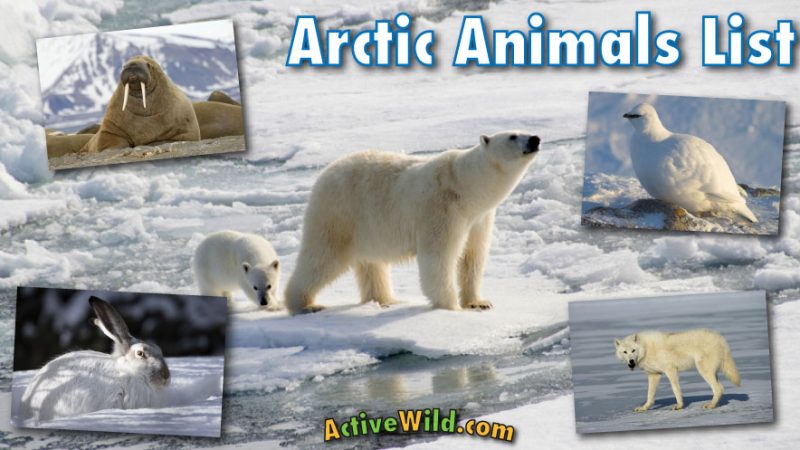The Arctic is one of the coldest and most extreme environments on Earth, yet it is home to some of the most fascinating wildlife. Animals in the Arctic have evolved incredible adaptations to survive frigid temperatures, icy waters, and long, dark winters. From the mighty polar bear to the mysterious narwhal, each species plays a crucial role in this unique ecosystem. This article will introduce you to 10 astonishing creatures that call the Arctic home.
Polar Bear – The King of the Arctic
The polar bear (Ursus maritimus) is the largest land carnivore and one of the most famous animals in the Arctic. With thick fur and a layer of blubber, it is well-adapted to the freezing temperatures of the region. Polar bears primarily hunt seals, using sea ice as their hunting ground. Unfortunately, due to climate change, the melting ice is threatening their habitat, making it harder for them to find food. Conservation efforts are crucial to protecting this iconic Arctic predator.
Arctic Fox – The Master of Camouflage
The Arctic fox (Vulpes lagopus) is one of the most adaptable animals in the Arctic, thriving in temperatures as low as -50°C. It changes the color of its fur with the seasons—white in winter to blend with the snow and brown in summer for camouflage. This small but resilient predator feeds on lemmings, birds, and fish while also scavenging leftovers from larger predators. Its thick fur-covered paws help it move across ice and snow effortlessly. Despite harsh conditions, the Arctic fox remains a symbol of survival in the tundra.
Narwhal – The Unicorn of the Sea
Narwhals (Monodon monoceros) are among the most intriguing animals in the Arctic, famous for their long, spiral tusk, which can grow up to 10 feet. This tusk, actually a large tooth, contains thousands of nerve endings and helps narwhals sense their environment. These whales rely on echolocation to navigate the dark Arctic waters and locate fish, squid, and shrimp. Narwhals spend most of their lives in icy waters, migrating seasonally between deeper and shallower areas. Due to climate change and increasing human activity, their populations are now under threat.
Snowy Owl – The Arctic’s Silent Hunter
The snowy owl (Bubo scandiacus) is one of the most striking animals in the Arctic, with its pure white plumage and piercing yellow eyes. Unlike many owl species, snowy owls are active during the day, especially in summer when the Arctic experiences continuous daylight. They primarily feed on lemmings but also hunt small birds and mammals. Their thick feathers provide excellent insulation, allowing them to withstand harsh Arctic winds. Snowy owls play a vital role in controlling rodent populations, maintaining the delicate balance of the Arctic ecosystem.
Arctic Hare – A Speedy Survivor
The Arctic hare (Lepus arcticus) is a fast and resilient species, perfectly adapted to the extreme Arctic climate. Like other animals in the Arctic, it has thick fur that helps retain body heat, changing from brown in summer to white in winter for camouflage. Arctic hares are herbivores, feeding on mosses, lichens, and woody plants, even digging through snow to find food. Their powerful hind legs allow them to escape predators like Arctic foxes and wolves by running at speeds up to 60 km/h. These adaptable creatures are key to the Arctic food chain, providing sustenance for many predators.
Beluga Whale – The White Ghost of the North
Beluga whales (Delphinapterus leucas) are among the most social animals in the Arctic, known for their white color and high-pitched vocalizations. These whales use echolocation to navigate the dark, ice-covered waters and communicate with each other in a complex system of clicks and whistles. Belugas migrate seasonally, moving to warmer waters in the winter and returning to the Arctic in the summer. Unlike other whales, they lack a dorsal fin, which allows them to swim easily under the ice. However, increasing noise pollution and climate change threaten their fragile Arctic habitat.
Musk Ox – The Ancient Arctic Wanderer
The musk ox (Ovibos moschatus) is one of the oldest surviving animals in the Arctic, dating back to the Ice Age. It has an extremely thick coat, with a soft underlayer called qiviut, which is one of the warmest natural fibers in the world. Musk oxen live in herds for protection, using a defensive circle formation against wolves and other predators. These herbivores graze on Arctic grasses, lichens, and shrubs, even digging through deep snow to find food. Despite their resilience, musk oxen populations are vulnerable to habitat loss and climate change.
Walrus – The Ice-Loving Giant
Walruses (Odobenus rosmarus) are one of the most recognizable animals in the Arctic, known for their long tusks and massive size. These tusks help them climb onto ice floes and are also used for defense against predators. Walruses primarily feed on clams and other shellfish, using their sensitive whiskers to detect food on the ocean floor. They are highly social animals, often found resting in large groups on ice or shorelines. However, due to melting sea ice, walruses are being forced to travel farther for food, putting them at greater risk.
Puffin – The Arctic’s Colorful Seabird
Puffins (Fratercula arctica) are among the most colorful animals in the Arctic, thanks to their bright beaks and striking black-and-white plumage. These seabirds are expert divers, using their wings to “fly” underwater while catching fish. Puffins nest in rocky cliffs, laying their eggs in deep burrows for protection from predators. During winter, their beaks fade in color but regain their vibrancy in mating season. Unfortunately, overfishing and climate change are affecting their food supply, threatening puffin populations.
Reindeer – The Arctic’s Legendary Migrator
Reindeer (Rangifer tarandus), also known as caribou in North America, are famous for their long migrations across the Arctic tundra. These herbivorous animals in the Arctic have specialized hooves that adapt to different seasons—broad and spongy in summer for traction, and sharp in winter to dig through snow for food. They primarily feed on lichens, mosses, and grasses, sustaining themselves through the long, harsh winters. Reindeer play a critical role in Arctic ecosystems and indigenous cultures, serving as a vital resource for food, clothing, and transportation.
Conclusion
The Arctic is home to an astonishing variety of wildlife, each uniquely adapted to one of the harshest environments on Earth. These animals in the Arctic have evolved to survive extreme cold, long winters, and an ever-changing climate. However, threats such as climate change, habitat destruction, and human activity are putting many of these species at risk. Protecting the Arctic and its incredible wildlife is essential for maintaining the delicate balance of this unique ecosystem.
FAQs
Q1. What is the largest predator in the Arctic?
The polar bear is the largest predator, relying on sea ice to hunt seals for survival.
Q2. How do animals in the Arctic survive extreme cold?
They have evolved adaptations such as thick fur, blubber, and metabolic changes to conserve heat.
Q3. Why do Arctic animals have white fur?
White fur provides camouflage in snowy environments, helping both predators and prey avoid detection.
Q4. What is the biggest threat to Arctic wildlife?
Climate change is the biggest threat, leading to habitat loss, reduced food sources, and increased human activity.
Q5. Are there migratory animals in the Arctic?
Yes, reindeer, Arctic terns, and some whale species migrate long distances to find food and breeding grounds.
Also read: What Animals Live in the Arctic? 10 Majestic and Fearless Creatures That Thrive in the Cold









